1
Fascinating belugasAround 2000
St. Lawrence River, Tadoussac region, Quebec, Canada
 Credits:
Credits:Les Productions Vic Pelletier Inc.
Narration: Pierre Béland
2
"White porpoise," "sea canary," "beluga": all names to designate the favourite species of professional and amateur whalewatchers, and of tourists, who marvel at their sihouettes outlined at the water's surface. Their colour and seemingly permanent smile make them very attractive animals."Delphinapterus leucas," the beluga's scientific name, means "white dolphin without fins." In place of a dorsal fin, it has a ridge, with which it breaks pack ice when surfacing to breathe. Belugas live in Arctic and subarctic waters. In summer, belugas in northern areas migrate toward the mouth of the Churchill River and Hudson Bay. Belugas in the St. Lawrence River, on the other hand, do not migrate. They live permanently in the river's estuary and the gulf, where they have an arctic microclimate that suits them perfectly. The specific territory of the St. Lawrence belugas was established when the Laurentide glacier melted and the Champlain Sea receded.
Well-adapted to the cold waters in which they are born, feed, reproduce and die, belugas have fusiform bodies, with heavily notched tail flukes at the end. Their pectoral flippers are relatively short and round. Belugas are wrapped in a heavy layer of blubber, which is covered with smooth skin without glands. The thickness of the blubber varies from one body part to another, from 6 cm to more than 25 cm. The skin and blubber make up just over 43% of the animal's total weight. Males, which can weigh up to 1,400 kg and are on average 4.5 m long, are slightly larger than females. Although their necks appear to be static, they can be moved.
The beluga belongs to the suborder Odontoceti; therefore, it is a toothed cetacean rather than one equipped with baleen plates for feeding. Belugas use their 26 to 42 teeth to catch their prey, which they swallow whole. They also suck up other prey. Belugas' teeth grow in when they are weaned at around two years old, and continue to grow throughout their lives. A beluga's age can be determined by looking at a longitudinal section of the teeth, like the growth rings of a tree.
Belugas' lungs allow them to breathe like us. Instead of nostrils, they have a blowhole in the shape of a half moon on the tops of their heads. When they are less active, belugas surface to breathe every five to ten minutes. Observers have recorded periods of up to 30 minutes without surfacing. However, when they swim, they breathe every 10 to 15 seconds. When they surface, their breath can spray up to two metres in the air. Rarely visible, it consists of vapour in the air that they push out of their lungs and water above their blowholes. In a single breath, they exchange nearly all of the air in their lungs. The water pressure closes their blowholes when they dive again. Young belugas breathe more often than adults, and sometimes breathe awkwardly.
Humans were the St. Lawrence beluga's main predator. In Arctic waters, killer whales and polar bears also hunt belugas, along with humans. When not being hunted, belugas swim at a speed of about six knots.
From birth to adulthood, belugas have different names, depending on the colour of their skin, which changes with age. Newborns, called "calves," are brown. This colouring turns blue and the young animals are then called "juveniles" ("bleuvets" in French). Around the age of three, the blue skin turns greyish and belugas are called the same thing as baby seals in French: "blanchons." The beluga does not get its distinctive white coat until it is 8 to 10 years old.
Like its cruising speed, the beluga's reproduction rate is not very fast. Females reach sexual maturity around the age of six, sometimes later. Males have to wait another year or two before being able to reproduce. In the spring, mating occurs and the gestation period, which lasts about 15 months, begins. A single calf is born every three years, and calves live for 20-25 years on average.
Belugas are social animals. Generally, the largest groups are made up of females accompanied by their newborns and their young from the previous year. Of the five senses, hearing is the most developed and a wide variety of sounds form the basis for their communication system. Although they live in totally different environments, bats and belugas share something in common: they use echolocation to analyze their surroundings. They emit ultrasonic sounds, and the echo that comes back gives them information about the size, shape, structure and even the texture of the object. Belugas' craniums, rostrums and jaws, as well as their melons, amplify the sounds they produce. They can move and change the shape of their melons to facilitate sound emission and reception.
The beluga was one of the first cetaceans to be kept in captivity, perhaps because of its small size, its chattiness or its colour. It is said to be easy to tame. In the mid-1800s, New York's Barnum Museum exhibited a St. Lawrence beluga. Nowadays, they are more commonly found in water parks and, fortunately, their living conditions in captivity have improved.
3
Pod of belugasAround 2005
St. Lawrence River, Tadoussac region, Quebec, Canada
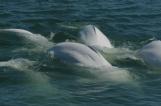 Credits:
Credits:GREMM
Unknown photographer
4
Daddy sculpin (Myoxocephalus groenlandicus)18 October 2008
Pointe de la Rivière Ouelle, Rivière-Ouelle, Quebec, Canada
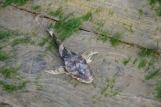 Credits:
Credits:Photograph: Judith Douville
5
Belugas breaking the surface with their heads to breatheAround 2005
St. Lawrence River, Tadoussac region, Quebec, Canada
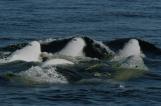 Credits:
Credits:GREMM
Unknown photographer
6
Beluga expelling airAround 2005
St. Lawrence River, Tadoussac region, Quebec, Canada
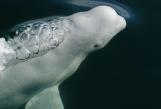 Credits:
Credits:GREMM
Unknown photographer
7
A calf surfacing to breatheAround 2002
St. Lawrence River, Tadoussac region, Quebec, Canada
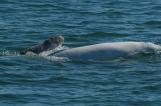 Credits:
Credits:GREMM
Unknown photographer
8
Juvenile beluga surfacing near its motherAround 2005
St. Lawrence River, Tadoussac region, Quebec, Canada
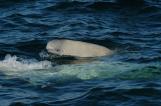 Credits:
Credits:GREMM
Unknown photographer
9
Juvenile beluga sticking close to its motherAround 2005
St. Lawrence River, Tadoussac region, Quebec, Canada
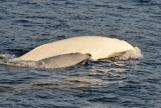 Credits:
Credits:GREMM
Unknown photographer
10
"Nos ancêtres à l'oeuvre à la Rivière-Ouelle," written by Madame Elphège Croff31 July 1931
Rivière-Ouelle, Quebec, Canada
 Credits:
Credits:Mrs. Elphège Croff (1896?1986)
"Nos ancêtres à l'oeuvre à la Rivière-Ouelle," Montreal, Éditions Albert Lévesque, 1931
11
Belugas are social animalsAround 2005
St. Lawrence River, Tadoussac region, Quebec, Canada
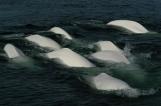 Credits:
Credits:GREMM
Unknown photographer
Marine mammal research and education group (GREMM)
12
Conditions in the beluga's natural habitat continue to pose problems. Its situation remains worrisome. Should we say "sick as a beluga"? Since 1982, autopsies has been performed on every beluga found dead. These mammals are stressed by noise and by the deteriorating quality of their habitat. Pollution remains the main threat. Tissues of those belugas studied reveal greater levels of pollution than what was deemed harmful to lab animals. Reproductive disorders, cancer and gastric ulcers are only some of the most common ailments.At the top of the food chain, belugas absorb all the contaminants that have been ingested by the smallest organisms, up to the fish that constitute their diet. This concentration of contaminants, from one level to the next, is what is slowly killing belugas. A nursing female provides her calf with milk that is more contaminated than what she consumes. How many years would it take for newborns to ingest milk free of contaminants?
13
Seagulls perched on a dead belugaAround 2005
St. Lawrence River, Tadoussac region, Quebec, Canada
 Credits:
Credits:GREMM
Unknown photographer
14
Dead beluga washed up on shoreAround 2000
St. Lawrence River, Tadoussac region, Quebec, Canada
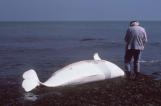 Credits:
Credits:GREMM
Unknown photographer